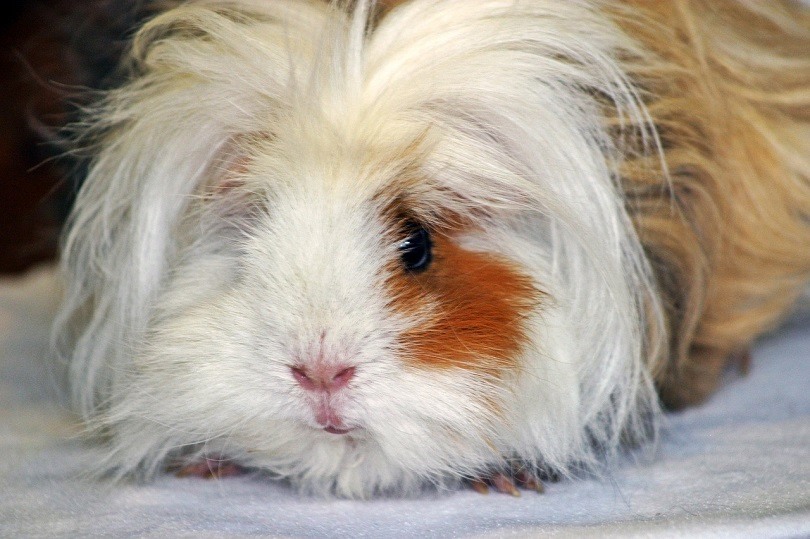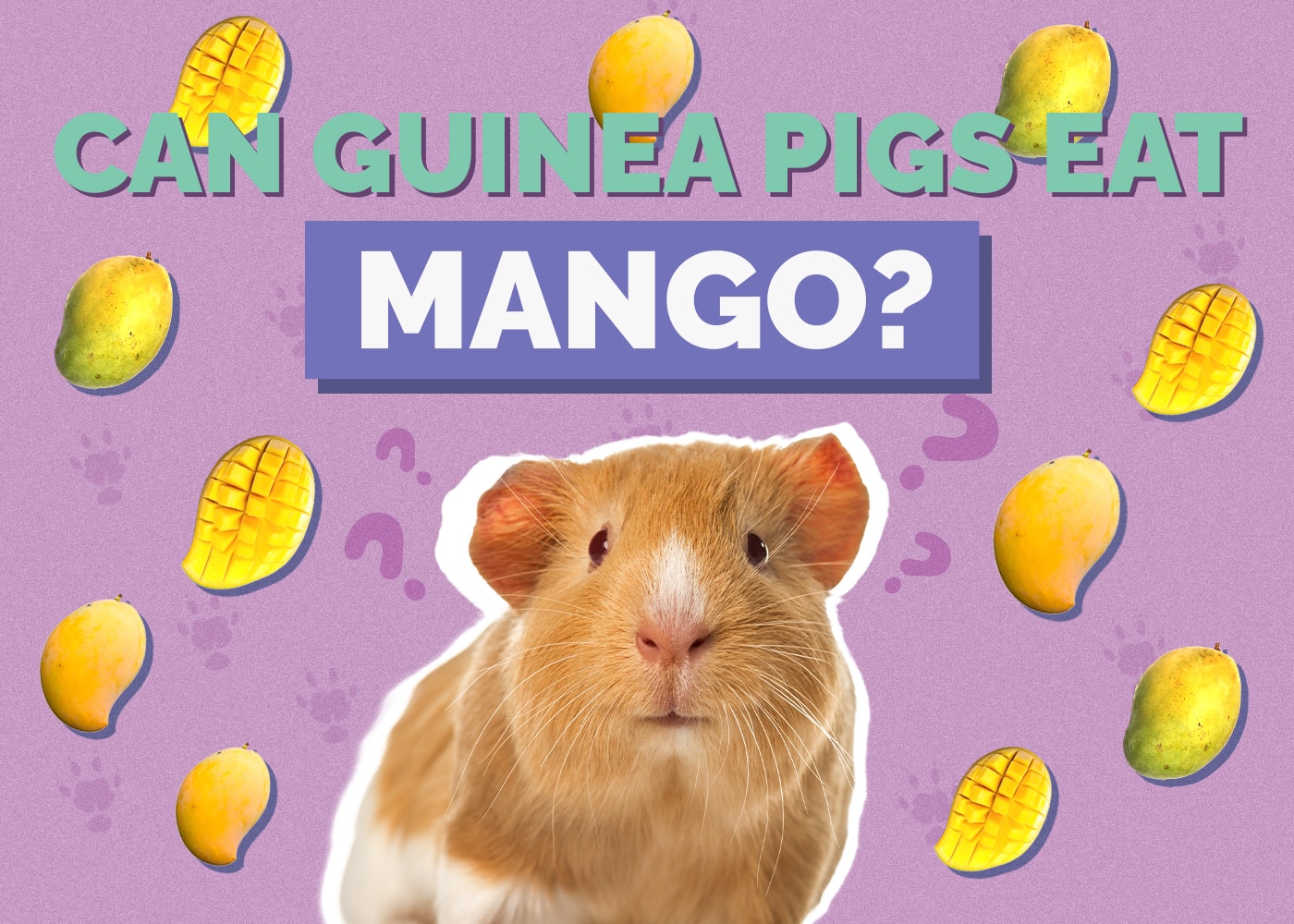Lunkarya Guinea Pig: Pictures, Lifespan, Behavior & Care Guide

Updated on

Click to Skip Ahead
The guinea pig is a popular species of small pet, but not all the breeds are well-known. The Lunkarya is adored for their stylishly messy hair, but they’re also one of the rarer guinea pigs. Social and mild-mannered, they are a hairy but delightfully friendly companion.
We explore the care needs and temperament of the Lunkarya and share intriguing facts about this breed in this guide.
Breed Overview
| Size: | 12 inches |
| Weight: | 1–3 pounds |
| Lifespan: | 5–6 years |
| Colors: | Peruvian, Texel, Silkie, Coronet |
| Suitable for: | Experienced owners with older children, homes with multiple guinea pigs |
| Temperament: | Easy-going, mild-mannered, gentle, low energy |
Affectionately nicknamed “Lunks,” the Lunkarya is a Swedish guinea pig breed that’s a variation of the Peruvian guinea pig. They’re a rare breed but are easy to recognize due to their thick, curly, and wooly fur.
There are three variations: the Lunkarya Peruvian, the Lunkarya Coronet, and the Lunkarya Sheltie. Each is distinguishable by their coat type, but they all share the same easy-going personality, long hair, and sociability.
Lunkarya Guinea Pig Characteristics
How Much Do These Guinea Pigs Cost?
The Lunkarya was first discovered in Sweden in 1986 by breeders of the Peruvian guinea pig. Many guinea pig lovers believe that the Lunkarya is the result of a cross between the Peruvian and another guinea pig breed. However, they’re actually a result of a naturally occurring genetic mutation in one of the Peruvians being bred at the time. This genetic mutation resulted in the thick, long, and curly fur that the Lunkarya is known for today.
Unfortunately, the breed is typically only found in the Nordic countries where they originated. This rarity means the Lunkarya is difficult to find in the U.S.A., and they’re not recognized by the American Cavy Breeders Association (ACBA). Few American breeders specialize in them.
You might be incredibly lucky and find someone who does breed Lunkaryas, and due to the limited demand, they’ll likely be affordable. It’ll also be difficult to find them in shelters, but keep an eye open, just in case.
Temperament & Intelligence of the Lunkarya Guinea Pig
There’s not much difference between the Lunkarya and other guinea pigs. Like other breeds, they’re sociable and prefer to be kept in a group, even if they’re not all the same breed. The Lunkarya is also intelligent and can learn to come when called, push a ball, use a litter tray, and do other basic tricks if you’re willing to put the time into training them.
Despite their grooming needs, Lunkaryas are easy-going pets with a mild-mannered temperament and docile nature. They can be timid when they’re not socialized properly, but when they’re familiar with being handled and comfortable with their surroundings, they’re confident and relaxed. Many of them are also outgoing and love to spend time with you outside of their enclosure.
Compared to some other breeds, they’re less energetic, but they still need physical and mental stimulation. You can keep them busy by giving them plenty of space to explore and toys to play with.
Do These Guinea Pigs Make Good Pets?
With their low energy and friendly nature, you might assume that the Lunkarya is an excellent first pet for children and new guinea pig owners. However, their care needs make them high maintenance.
Most of all, the Lunkarya needs an owner who is familiar with how to groom guinea pigs. Their long fur can easily get matted and clogged with urine and dirt. Staying on top of their grooming needs and recognizing the signs of skin infections is important.
You also have to consider how young your children are. While the Lunkarya is a gentle, friendly breed that gets along well with kids, they’re more suited to older children. Their small size and fragility mean it’s easy for them to get hurt, and kids need to know how to properly handle guinea pigs. Small children will need to be supervised with your Lunkarya to make sure they don’t accidentally scare or hurt your pet.

Does This Guinea Pig Get Along With Other Pets?
Like other guinea pig breeds, the Lunkarya is naturally social. In the wild, guinea pigs are herd animals, and their domesticated cousins share this sociability. As a result, your Lunkarya will flourish the most when they’re kept with another guinea pig or two. They don’t need to be the same breed; as long as your Lunkarya has a guinea pig friend, they’ll thrive.
Other pets, such as cats and dogs, are where the issues come in. Cats and dogs are more likely to scare your Lunkarya, especially if they crowd the enclosure or catch your guinea pig outside of their cage.
Make sure your Lunkarya’s enclosure is secure and kept well out of your cat or dog’s reach. Never leave your guinea pig unattended with them either, even if you only step out of the room for a few minutes. Cats and dogs are natural predators and might scare, injure, or kill your guinea pig.
Things to Know When Owning a Lunkarya Guinea Pig
A guinea pig is frequently believed to be a good choice for a first pet, especially where children are concerned. However, the Lunkarya has needs that have to be met to make sure they stay happy and healthy.
Unfortunately, this means they’re not recommended for new guinea pig owners. Still, with the right guidance and a willingness to learn, taking care of a guinea pig isn’t difficult to do. Except for their grooming requirements, Lunkaryas have the same needs as any other guinea pig. Here’s a quick care guide to get you started.
Food & Diet Requirements
About 80% of your Lunkarya’s diet should consist of fresh, high-quality hay. Your guinea pig should always have hay in their enclosure so they can eat it throughout the day. This keeps their digestive system working correctly and helps them manage their dental health.
Vitamin and mineral supplements are ideal to add to your Lunkarya’s diet. Leafy green vegetables like cabbage, kale, parsley, and cilantro are great daily additions to their diet and provide plenty of vitamin C. You should also use hay-based pellets that are specifically formulated for a guinea pig’s nutritional requirements.
Make sure you don’t overfeed them! The Lunkarya is one of the less-energetic breeds of guinea pig, and too much food can lead to obesity. Always make sure they have fresh water available and in easy reach.

Habitat & Enclosure Requirements
Guinea pigs might be small, but they need more space than you might think. Your Lunkarya needs room to explore, nest, go to the bathroom, and eat. One guinea pig needs a minimum of 7.5 square feet of space. Since cavies are highly sociable and always do better in a pair or a group, you’ll likely need a larger enclosure.
There are two types of enclosures. You can use a cage that’s secure on all sides—this is always the recommended option if you have a cat or dog that might be tempted to harass your Lunkarya—or you can use an open run, as long as the sides are at least 12 inches high.
Whichever enclosure you use, make sure it’s easy to clean and well-ventilated and doesn’t have a wire base that can hurt your pet’s feet. Always make sure you use paper bedding. Wood shavings can contain chemicals that can cause serious health issues in guinea pigs.
Exercise & Sleeping Needs
Providing plenty of space for exercise and a safe, secure spot for sleeping is vital for your Lunkarya’s welfare. For their bedding spot, make sure they have a safe box to nest in, and use paper bedding.
As for their exercise needs, ensure that they have plenty of space in their enclosure to run around in. This is even more crucial if you have more than one guinea pig. Lunkaryas aren’t the most active guinea pig breed, but they do need opportunities to exercise.
Give them regular floor time out of the cage. This way, they can interact with you and the rest of the family and explore somewhere new. Make sure they’re supervised and in a safe, guinea pig-proof room.

Training
Guinea pigs might not be the first pets that you think of as trainable, but they are smart animals. Your Lunkarya won’t be running an agility course anytime soon, but they are fully capable of learning basic tricks.
Using their favorite treats and affection as rewards, along with consistent commands and dedication, you can teach them how to use a litter tray and come when they’re called. Some Lunkaryas have even learned how to push a ball or spin in a circle.
Grooming
Your Lunkarya’s grooming needs are where they’re higher maintenance than other breeds. Their long hair easily gets matted and tangled. The fact that it collects debris from their enclosure and the room that they’re in during floor time means they’re prone to skin infections. To keep them healthy, you need to spend time grooming them every day or give them a quick bum bath or spot clean to get rid of stubborn clumps of poop or urine.
Use a small comb, and be gentle when you brush your Lunkarya. Many guinea pigs enjoy the attention, but they can also be easily scared, so make sure you reassure them, and keep plenty of treats handy so they enjoy themselves. Daily grooming sessions are a great way to bond with your pet too.
Regular grooming sessions enable you to search for sores or tumors on your Lunkarya’s body and check their teeth, ears, and feet. With the right diet, your Lunkarya’s teeth will be worn down naturally, but it’s still wise to make sure they’re not impacted. Their claws will need to be trimmed once or twice a month.

Lifespan and Health Conditions
Lunkaryas might only live between 5 and 6 years, but they are a healthy breed, especially when you make sure their enclosure is safe and their diet is nutritionally balanced. Like most guinea pigs, they’re susceptible to respiratory illnesses and GI stasis. Their long fur also makes them susceptible to flystrike, especially when their coat isn’t kept clean.
- Skin infections
- Bumblefoot
- Flystrike
- Respiratory infections
- Inner ear infections
- GI stasis
Male vs. Female
Appearance and temperament-wise, there’s little difference between male and female Lunkarya guinea pigs. They all have the same wayward fur and friendly, gentle temperaments. You’ll have to make sure they’re spayed or neutered if you plan to keep both sexes together but don’t want to breed them.
There is a slight difference when it comes to their sociability. Female guinea pigs generally get along better in larger groups, while males prefer to be in a pair, though you can keep a single male with several females. Make sure you consider the number of guinea pigs that you want to keep or the sex of the guinea pigs that you’re planning on introducing your new Lunkarya to before choosing a male or female.
3 Little-Known Facts About the Lunkarya Guinea Pig
Guinea pigs are intriguing animals, and the rarity of the Lunkarya makes them even more fascinating. They might not be as well recognized as the other breeds that you’re familiar with, but they still have an interesting history.
1. There Are Three Variations
The Lunkarya might not be a recognized breed, but there are still three variations. All three have the distinguished, long, curly locks unique to the breed, but the way that they fall makes it easy to tell the variations apart.
Lunkarya Peruvian guinea pigs have prominent forelocks, the Lunkarya Sheltie has hair that flows backward, and the Lunkarya Coronet has a crown-like crest on their forehead.
2. Their Coat Grows Incredibly Quickly
A Lunkarya guinea pig’s hair will grow at a rate of 1 inch every month. It’s not always easy to notice this, though, because their long fur is so curly and often appears shorter than it is.
To measure it accurately, you’ll need to gently uncurl a section of hair and hold it straight. Depending on how calm your Lunkarya is when handled, you might find this easier with a friend’s assistance.

3. Their Hair Cannot Be Tamed
Another fascinating fact about the Lunkarya’s stylish fur is how untamed it is. You’ve probably dealt with bad hair days of your own, but with enough patience, they can usually be managed with a hat. However, with the Lunkarya, their hair is naturally inclined to never do what you want it to.
While you might grab the comb to brush it every day, it’ll never lose the ruffled but stylish mess that the dense curls fall in. This isn’t a bad thing, of course. Our bad hair days might make us cringe, but if anyone can pull off the just-out-of-bed look, it’s the Lunkarya guinea pig!
Final Thoughts
A variation of the Peruvian guinea pig, the Lunkarya is the result of a genetic mutation that resulted in dense ringlets rather than silky fur. Although the breed was first developed in 1986, they’re not one of the most well-known breeds and are still rare in the U.S.A. If you’re lucky enough to find one, you’ll find that they’re just as friendly and sociable as other guinea pig breeds.
While they’re not that energetic, the Lunkarya can be trained to perform basic tricks and are delighted to spend time with people and other guinea pigs. They’re mild-mannered, gentle, and confident, especially when they’re comfortable with their surroundings.
Make sure you’re familiar with their grooming needs before you consider keeping one. Their fur gets tangled easily and quickly clogged with debris. They need an owner who’s familiar with grooming guinea pigs and who can spare time to brush them every day to keep them healthy.
Featured Image Credit: Jolly-Sunshine, Pixabay










